Agoura Hills is entering a period of rapid change, especially around the Agoura Village area near Kanan and Agoura Roads. Several major projects – mostly mixed-use and housing-focused – are planned or underway, alongside key infrastructure and open-space efforts. Below is a condensed overview of the main projects, their status, community response, and likely real estate impacts.
Agoura Village Specific Plan and State Housing Mandates
The Agoura Village Specific Plan (AVSP) is a long-term vision to turn the Agoura/Kanan area into a walkable village with mixed-use buildings and a town center feel. At the same time, California’s housing mandates require Agoura Hills to plan for 318 affordable units by 2029, pushing the city to zone about 20 sites (many in Agoura Village) for new housing.
This creates tension: the state is pushing density and affordability, while many residents prioritize wildfire evacuation, traffic, and environmental protection. Every project below sits in this conflict between growth and safety.
West Village Mixed-Use Project
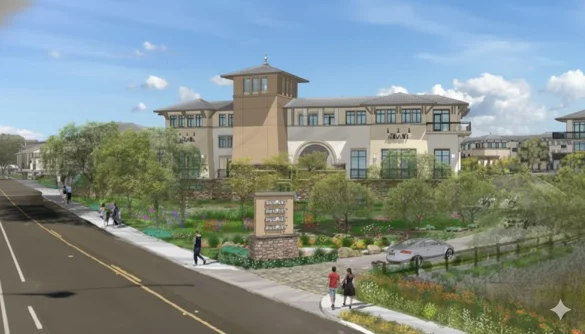
Location & Concept:
On the long-vacant lot at the southwest corner of Kanan and Agoura Roads (the seasonal pumpkin/Christmas tree lot), West Village would be a high-density, mixed-use complex with:
- 238 apartment units in 3–4 story buildings
- A 4-story parking structure
- About 9,000 sq. ft. of commercial space (restaurant + retail)
Status:
Approved by the City Council in 2020 but now tied up in litigation from residents’ groups over safety and environmental issues.
Key Concerns:
The site lies at the base of Ladyface Mountain and next to Lindero Canyon Creek, raising habitat and visual-impact worries. More urgently, it sits at the crucial Kanan Road–101 Freeway evacuation junction, the main wildfire escape route for the Santa Monica Mountains and Malibu. Opponents argue concentrating the city’s highest density at this chokepoint in a Very High Fire Hazard Severity Zone is dangerous and that environmental review was inadequate. Lawsuits led by PRISMM and resident Steve Hess aim to overturn approvals on public safety and CEQA grounds.
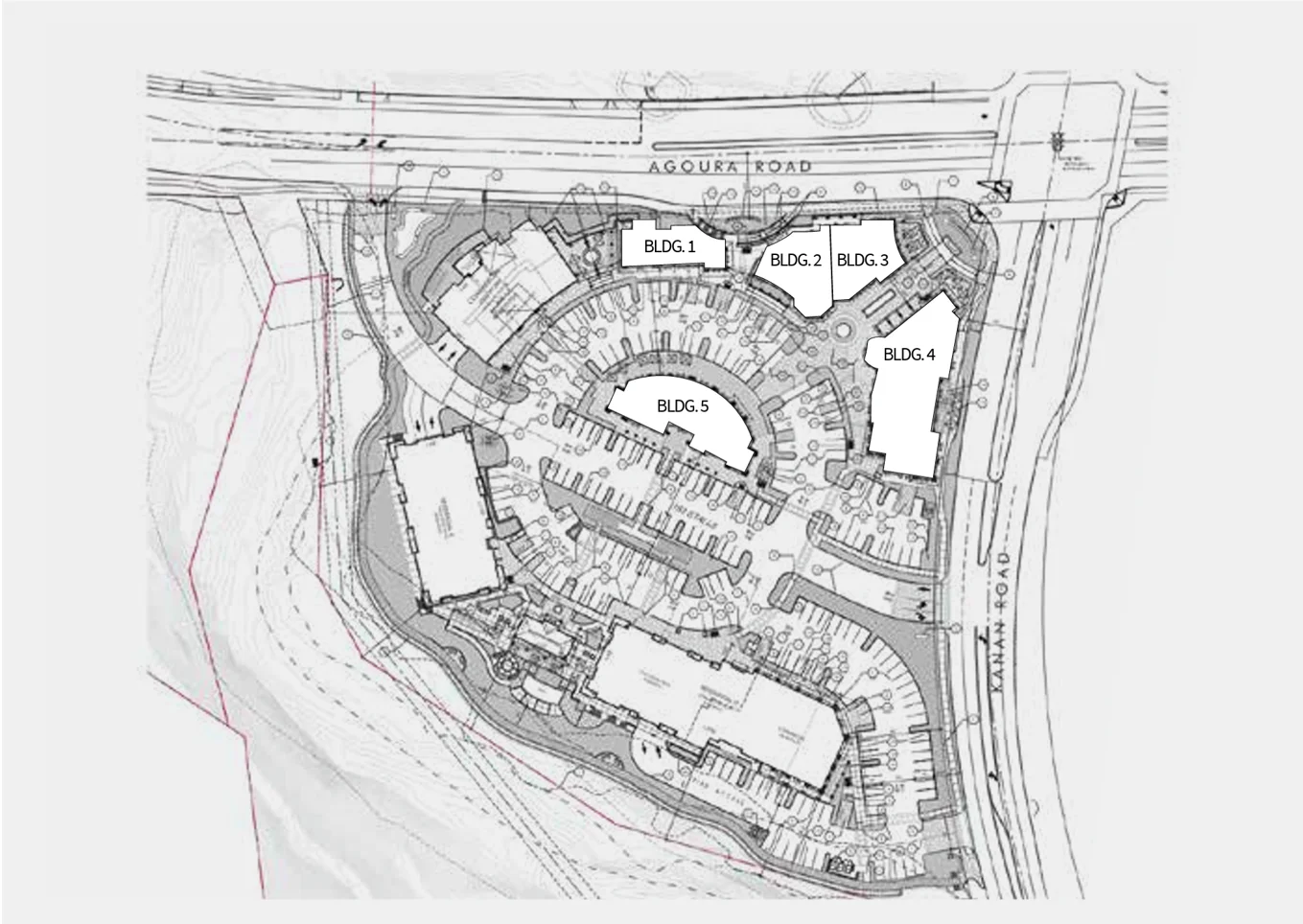
Pros & Support:
Supporters say West Village would add badly needed housing (including some affordable units), activate a vacant lot, and boost tax revenue. Concentrating growth near the freeway and existing shopping is seen as “smart growth” versus building deeper into open space, and the project would be built to modern fire and energy codes.
Big Picture:
West Village is a test case: it could deliver housing and a more vibrant village core, but it also symbolizes fears around wildfire evacuation and overbuilding at Kanan/101. The lawsuit outcome will heavily influence Agoura’s development path.
Agoura Hills “Regency” Housing Project (Former Theater Site)
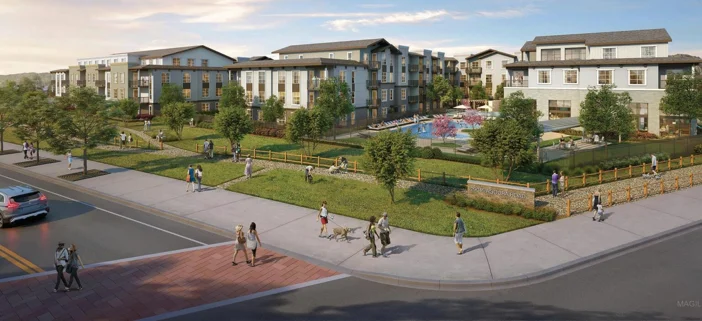
Location & Concept:
At the northwest corner of Agoura Road and Cornell Road (former Regency movie theater and parking lot), a private developer is building the first major Agoura Village housing project:
- 4-story apartment building wrapping the site
- 4-story parking garage
- Ground-floor restaurant
- 278 apartments (up from 152 via Density Bonus), with 38 affordable units and 471 parking spaces
Status:
Approved and under construction; this is the first large project residents will physically see rise in Agoura Village.
Concerns:
Like West Village, it sits in the Wildland-Urban Interface and a Very High Fire Hazard Severity Zone at the base of Ladyface Mountain. Critics say nearly 300 households funneled toward Kanan/Agoura add to evacuation risk and traffic. Some mourn the loss of a small-town landmark (the theater) and dislike the visual shift to 4-story massing.
Pros:
Provides substantial new rental housing, including affordable units, on an already-paved commercial site rather than open space. It supports nearby businesses (like Whizin Market Square) and gives options to renters and downsizing seniors who want to stay local. Real-estate-wise, it should add significant rental inventory around 2026, potentially easing rent pressure but likely at fairly high price points.
Significance:
The Regency project is a bellwether. If it integrates well, it may normalize multi-family development in Agoura Village. If it amplifies traffic or safety worries, it will harden resistance to later projects.
Former “Cornerstone” Site – from Controversial Project to Open Space
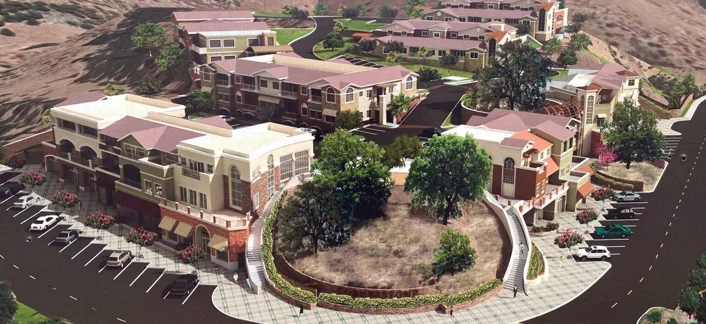
Original Plan:
The southeast corner of Agoura Road and Cornell Road (the “Agoura Cornell Knoll”) was once approved for Cornerstone – a mixed-use project with about 35 apartments plus retail, restaurant, and office space (~116,000 sq. ft.) terraced into a prominent oak-covered hill.
Why It Failed:
The site hosts rare native plants and is considered a Chumash archaeological area. Cornerstone required massive grading (removing about 75% of the knoll and most of its 199 oak trees), clashing with the city’s oak protection ordinances and the AVSP’s preservation intent. Residents formed STACK (Save the Agoura Cornell Knoll) and, with the California Native Plant Society, sued under CEQA. In 2020 a Superior Court judge ruled in their favor on most counts, overturning approvals. Appeals failed; by 2022 higher courts had effectively killed the project.
Outcome – Permanent Open Space:
In late 2022, the Mountains Recreation and Conservation Authority (MRCA) purchased the 8.2-acre site for about $2.63 million. It is now preserved as open space, expanding the Liberty Canyon wildlife corridor and connecting to regional parkland. The site protects rare plants like the Agoura Hills dudleya and maintains iconic views of Ladyface Mountain.
Implications:
Cornerstone’s defeat removed 35 housing units from the pipeline, increasing pressure on other sites to deliver housing but reinforcing Agoura’s conservation identity. Nearby homeowners gain permanent views and open space, which likely bolsters long-term property values.
Gateway Church / Warmington Residential Project (29646 Agoura Road)
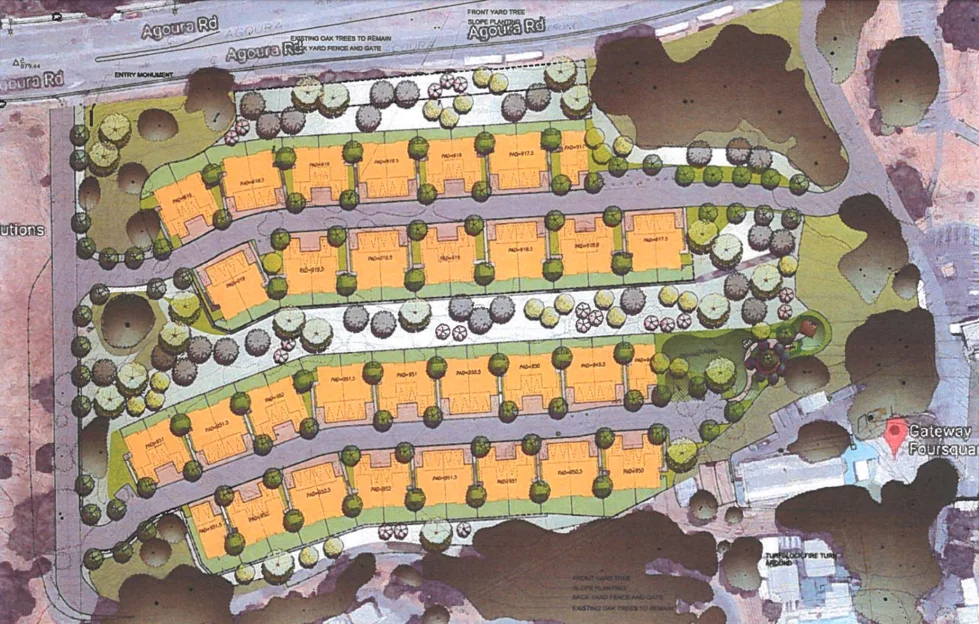
Location & Concept:
On 109 acres owned by Gateway Church at 29646 Agoura Road, the church and Warmington Residential propose:
- Subdividing into 5 lots
- Lot 1: 66 gated, 2-story condominium homes on ~9.5 acres (4–5 bedrooms, ~2,000 sq. ft. each plus garages)
- Lot 2: new ~25,800 sq. ft. two-level sanctuary building
- Existing church retained; remaining hillside land largely left as open space or future use
Status:
A public forum was held in 2022. As of late 2025, the plan is under city review and may require General Plan/zoning changes. No construction yet.
Pros:
At 66 homes on 9.5 acres, density is moderate and visually closer to a traditional single-family neighborhood. Much of the 109 acres remains hillside open space. It adds owner-occupied housing in a format that fits Agoura’s suburban character and helps the church fund improved facilities.

Concerns:
The site is near Ladyface’s slopes and was threatened by the Woolsey Fire, so fire risk and evacuation remain central concerns. Neighbors worry about more traffic on Agoura Road and construction disruption. Some feel the affordable component (only a few units) is too small relative to the risk.
Real Estate Impact:
If approved, these new homes would likely be premium-priced ($1M+), offering rare new construction in Agoura and potentially setting new benchmarks. They could attract families seeking modern homes while reinforcing demand for local schools and services.
Dorothy Drive Townhomes (28000 Dorothy Drive)
Location & Concept:
On a lightly developed site at 28000 Dorothy Drive, east Agoura Hills near the 101/Reyes Adobe interchange, a townhome project is under review:
- About 60 townhome units, likely 2–3 stories
- Attached/semi-attached homes aimed at first-time buyers or downsizers
- Some potential affordable units (details unclear)
Status & Context:
As of 2025, the project is in planning review, with no construction yet. The area already has some condos and apartments, making this a logical infill site rather than an intrusion into single-family streets.
Pros & Concerns:
Pros include moderate-density homeownership in a convenient, freeway-adjacent location that doesn’t encroach on major open space or primary wildfire corridors. Cons center on expected traffic, school impacts, and questions about height, parking, and neighborhood fit. Overall, it is likely to be less controversial than Agoura Village projects.
“Tiny Homes” Project in Old Agoura (Driver Ave / Colodny Drive)
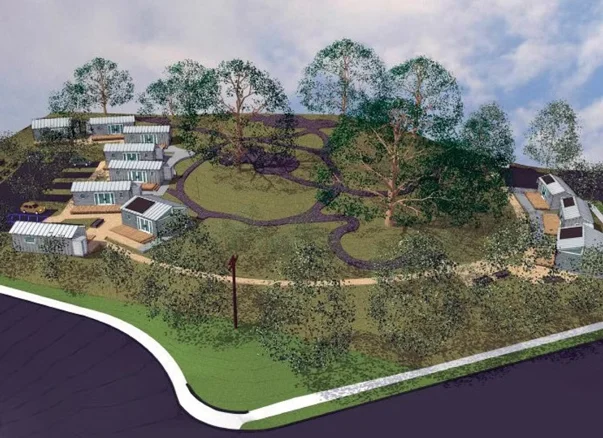
Concept:
On a city-owned lot at Driver Avenue and Colodny Drive, the city proposes a small cluster of very small cottages:
- Initially zoned for up to 33 units
- Scaled back to about 11 “tiny” cottages (300–500 sq. ft., 1 bed/1 bath)
- Intended as affordable housing for singles or couples
Status:
Still in planning. The downsize from 33 to 11 reflects attempts to address neighborhood concerns.
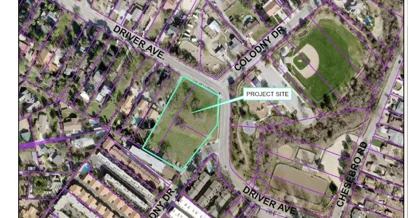
Community Response:
Old Agoura is semi-rural and equestrian, and many residents feel even 11 micro-homes don’t fit the area’s character. Concerns include local traffic, evacuation capacity, and fears (sometimes NIMBY-tinged) about low-income housing.

Pros & Real Estate Effect:
If designed to match the rustic setting, this could be a gentle-infill model that provides rare starter or downsizing options without big visual bulk. With just 11 units, the market impact is minimal but symbolically important for local affordability and diversity.
Ladyface Greenway Linear Park Project

Concept:
Formerly called the Linear Park, the Ladyface Greenway creates about 1.3 acres of new parkland by capping a 600-foot concrete flood channel (Palo Comado Creek) behind Whizin Market Square along Agoura Road:
- Native landscaping, botanical walking path, butterfly garden
- Picnic areas, small playground
- Multi-use trails (pedestrian/equestrian) linking to Santa Monica Mountains trail systems
- Integrated stormwater treatment and flood control infrastructure
Status:
A long-standing city priority, with design work completed and construction underway around 2024. As of late 2025, major channel-capping work is in progress; completion is expected within a couple of years.

Community Response & Benefits:
The park addresses the lack of public green space south of the 101 and will serve new residents in Agoura Village. It improves aesthetics, environmental quality, and trail connectivity, and is widely seen as a quality-of-life win despite construction disruptions and high costs. Properties near the greenway – including new apartments – will likely benefit from enhanced walkability and park access.
Pros and Cons of Agoura Hills’ Major Developments
Pros:
- Housing Supply: Hundreds of new units (apartments, townhomes, condos, cottages) help meet state mandates and offer more options for renters, young families, and seniors.
- Economic Revitalization: More residents and hotel guests mean more local spending and a broader tax base. Mixed-use projects and hotels support restaurants, shops, and jobs.
- Modern Infrastructure & Amenities: Projects bring upgrades. Parks, trails, better stormwater systems, sidewalks, and possible intersection improvements at Kanan & Agoura.
- Village Core & Vibrancy: Growth focused in Agoura Village could finally create a walkable “downtown” with cafés, gathering spaces, and a stronger sense of place.
- Environmental Mitigations & Wins: While development has impacts, it has also driven gains like the permanent preservation of the Cornerstone site and investment in the wildlife crossing and greenway. New buildings must meet stricter energy and fire codes.
- Real Estate Diversity: More varied housing types (luxury rentals, townhomes, senior options, tiny homes) broaden the market, keeping more residents in Agoura over different life stages.
Cons:
- Wildfire Evacuation & Safety: Concentrating dense housing at or near Kanan/101 worries many residents who fear gridlock in a major fire. Safety advocates see this as the top risk.
- Traffic Congestion: Added homes and hotels will bring more daily car trips. Key intersections like Kanan/Agoura and Reyes Adobe/Canwood may become noticeably busier without robust mitigations.
- Strain on Infrastructure & Services: More residents mean higher demand for water, schools, and emergency services in a drought-prone region. Upgrades will be needed and cost money.
- Loss of Open Space & Visual Change: Some previously low-rise or undeveloped areas will become more urban, especially around Ladyface, altering views and perceived small-town character.
- Community Division: Fierce debates, lawsuits, and “NIMBY vs YIMBY” tension strain civic cohesion and could shape local politics.
- Limited Affordability Gains: Critics note that most new units are market-rate and likely expensive, with only modest affordable components. There is skepticism these projects will meaningfully lower housing costs for working families.
Implications for Agoura Hills Real Estate
Market Dynamics:
New multi-family projects (notably West Village and Regency) and ownership products (Gateway homes, Dorothy townhomes) will significantly expand local inventory. This may cool the most extreme pressure on rents and home prices but is unlikely to push values down, given broader regional demand.
Value Patterns:
Homes near Agoura Village and the new park may gain from walkability and amenities, while those directly bordering construction or high-traffic routes may see temporary headwinds. Long term, preserved open spaces like the former Cornerstone site support surrounding property values by protecting viewsheds and recreational access.
Buyer Appeal:
Agoura Hills is evolving from a purely low-density suburb into a community with both traditional neighborhoods and a small urban core. This can attract young professionals and families who want nature plus convenience, while still appealing to buyers seeking quiet, established single-family tracts away from Agoura Village.
Future Uncertainty:
State laws (like SB 9/10) and macroeconomic shifts could further influence density and pricing, but for now most major changes are concentrated in planned sites. Interest-rate swings or a regional slowdown might affect absorption and pricing of new units but, given Agoura’s desirability, demand is expected to remain strong.
Agoura Hills is at a crossroads. Over the next 1–5 years, decisions about West Village, surrounding housing projects, open space preservation, and infrastructure like the wildlife bridge and Ladyface Greenway will shape the city’s character and real estate market for decades. Managed well, this wave of development can deliver more vibrancy and housing choice while preserving the scenic, close-knit feel that first drew people to Agoura Hills.